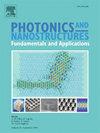Optical response of Au/n-Si schottky photodiode with an interface of graphite-Er2O3-doped polyvinyl alcohol (PVA) nanocomposite
IF 2.9
3区 物理与天体物理
Q3 MATERIALS SCIENCE, MULTIDISCIPLINARY
Photonics and Nanostructures-Fundamentals and Applications
Pub Date : 2025-09-01
DOI:10.1016/j.photonics.2025.101446
引用次数: 0
Abstract
In this study, the photoconductive properties of a Schottky photodiode with the structure Au/PVA:Graphite-Er₂O₃/n-Si are investigated both in the dark and under varying light intensities. A thin layer of the polyvinyl alcohol doped with Graphite-Er₂O₃ is placed at the metal-semiconductor interface to create an Schottky photodiode with a metal-nanocomposite-semiconductor structure. The fabrication and preparation techniques are thoroughly documented. X-ray diffraction (XRD) is used to analyze the Graphite and Er₂O₃ nanostructures. Several key photoconductive properties, such as leakage or reverse-saturation current (I₀), electric potential barrier height (ΦB0), and ideality factor (n), series/shunt resistances (Rs/Rsh), surface/interface state density distribution (Nss), photocurrent (Iph), photosensitivity (S), optical responsivity (R), and specific detectivity (D*) have been determined. Increasing light intensity leads to higher I₀ and n values, and lower ΦB0 and Rs values. When studying the illumination dependency of photocurrent, the Iph–P plots at zero bias voltage exhibit a linear behavior within an acceptable range. The PVA:Graphite-Er₂O₃ nanocomposite enhances the photosensitivity of the metal-nanocomposite-semiconductor type photodiode, optical responsivity, and specific detectivity by 1120, 2.40 mA/W, and 3.13 × 10 ¹ ⁰ Jones, respectively. These results suggest that the Au/PVA:Graphite-Er₂O₃/n-Si structure exhibits a promising photoresponse and could potentially replace traditional metal-semiconductor photodiode in optoelectronic devices and photovoltaic systems.
石墨- er2o3掺杂聚乙烯醇(PVA)纳米复合材料界面Au/n-Si肖特基光电二极管的光学响应
在这项研究中,研究了Au/PVA:石墨- er₂O₃/n-Si结构的肖特基光电二极管在黑暗和不同光强下的光导性能。在金属-半导体界面上放置一层掺杂石墨- er₂O₃的聚乙烯醇薄层,可以制造出具有金属-纳米复合材料-半导体结构的肖特基光电二极管。制造和制备技术是彻底的文件。采用x射线衍射(XRD)对石墨和Er₂O₃纳米结构进行了分析。几个关键的光导特性,如泄漏或反饱和电流(I 0)、电位势垒高度(ΦB0)和理想因数(n)、串联/分流电阻(Rs/Rsh)、表面/界面态密度分布(Nss)、光电流(Iph)、光敏性(S)、光响应性(R)和比探测率(D*)已经确定。随着光强的增加,I 0和n值升高,ΦB0和Rs值降低。当研究光电流的光照依赖性时,在零偏置电压下的iphp图在可接受的范围内呈现线性行为。PVA:石墨- er₂O₃纳米复合材料将金属-纳米复合材料-半导体型光电二极管的光敏性、光学响应率和比探测率分别提高了1120、2.40 mA/W和3.13 × 10 ¹ ⁰Jones。这些结果表明Au/PVA:Graphite-Er₂O₃/n-Si结构具有良好的光响应性能,有可能在光电器件和光伏系统中取代传统的金属半导体光电二极管。
本文章由计算机程序翻译,如有差异,请以英文原文为准。
求助全文
约1分钟内获得全文
求助全文
来源期刊
CiteScore
5.00
自引率
3.70%
发文量
77
审稿时长
62 days
期刊介绍:
This journal establishes a dedicated channel for physicists, material scientists, chemists, engineers and computer scientists who are interested in photonics and nanostructures, and especially in research related to photonic crystals, photonic band gaps and metamaterials. The Journal sheds light on the latest developments in this growing field of science that will see the emergence of faster telecommunications and ultimately computers that use light instead of electrons to connect components.

 求助内容:
求助内容: 应助结果提醒方式:
应助结果提醒方式:


